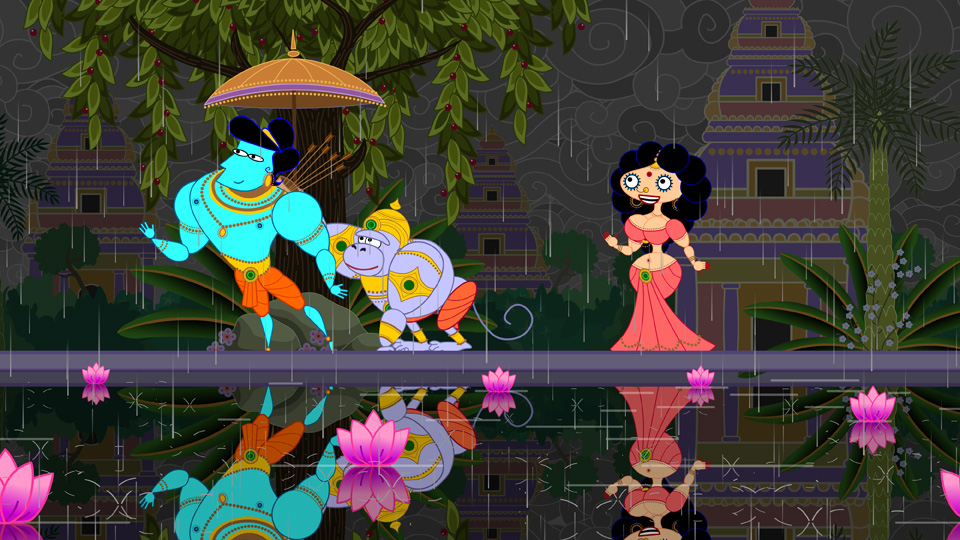
Sita Sings the Blues (2008) is an astonishing tour-de-force from the animation auteur Nina Paley, who wrote, designed, directed, animated, and edited the entire feature. It weaves together images and music in many styles, while depicting two parallel stories – a very personal tale of betrayal in Paley’s own life, and the story of Sita and Ram from Hindu legend.
The first story, told in interludes between the Sita narrative, begins with Paley happily married, living in San Francisco with her husband Dave and their cat Lexi. Dave is offered a temporary position working overseas in India for six months. When the duration of this job is extended, Nina moves to India to join him, leaving behind their home and cat in San Francisco. Dave is cold and unaffectionate to Nina in India, and when she returns to the States to pursue career opportunities of her own, Dave unceremoniously breaks off their relationship by email. In Nina’s grief, she begins to read the Hindu epic poem, the Ramayana of Valmiki, and sees parallels between her own situation and that of Ram’s wife Sita, ultimately leading to the creation of this film.
Though condensed from the epic poem that is its source, Sita’s story as interpreted through Paley’s film is nevertheless given a rich treatment through at least three layers of retelling. In the top layer, there is a trio of contemporary Indian people recounting and commenting upon the story among themselves. Then there is an acting out of each scene of Sita’s story, punctuated with some irreverent invented dialogue. Finally, there is a layer where the scenes are once again played out as musical numbers. This telling features smartly chosen recordings of singer Annette Hanshaw’s bluesy songs from the late 1920s, with Hanshaw’s lyrics supplying Sita’s emotional expression. As the retelling of the legend progresses, the thematic connection of Sita’s life to Nina’s experience becomes increasingly clear, as the innocent Sita is put upon and treated wrongly again and again by the men in her life, revealing a broad resonance to the particular injustices that Nina and Sita endure.
Nina’s story, and each of the layers of the telling of Sita’s story, are all given a unique visual design and animation style. For her autobiographical sections, Paley adopts a character design that is similar to the cartooning style in her own comic strip, “Nina’s Adventures,” but with the jittery animation reminiscent of the Squigglevision cartoons like Dr. Katz. The trio of storytellers are animated as south Asian shadow puppets, which also bring to mind the influence of Lotte Reiniger’s cut-out animated features such as The Adventures of Prince Achmed. The intermediate tellings of Sita’s story are enacted by animated illustrations resembling the traditional Rajput style of Indian painting. In one dream-like abstract sequence, Paley uses traditional rotoscope to depict the outlines of female dancers along with a hypnotic, pulsating collage of heart images. And the bouncy musical numbers where Sita sings with the voice of Annette Hanshaw look and move like updated versions of the simple geometry in rubber-hose cartoons of the 1930’s. The design of Sita herself is vaguely similar to one of the most popular animated characters of the early sound era, Betty Boop.
Along with this kaleidoscopic variety of visual styles, the music moves across borders and eras, including music by the Indian-inspired French electronic music band, Masaladosa, and pieces by the rock musician and composer, Todd Michaelsen in addition to the Hanshaw songs. At one point, there is even an ironic follow-the-bouncing-ball children’s ditty in praise of Rama, sung by Sita’s sons after Rama has abandoned her.
The musical and visual mash-up of styles could potentially lead to incoherence, but Paley draws it all together with a consistent sense of humor, and thematic unity. She uses the layers of storytelling to explore the way that timeless myths and deeply treasured stories can help shape meaning in our lives, even across cultural and temporal rifts. By layering multiple versions of Sita’s story upon each other, Paley obliquely comments upon the way that stories grow and morph in the retelling. She gives an implicit validation to the essential nature of oral telling, and to the communal experience of sharing and receiving stories. And in exploring the grief of one woman’s betrayal by her husband, she taps into the universality of the unjust burden upon women whose men are “mean to me,” as Annette Hanshaw croons.
I would be remiss not to note at least in passing, Paley’s meta-theme of anti-copyright. When constructing the film around what she believed to be public domain recordings, Paley encountered obscure copyright troubles, leading her to ultimately release Sita Sings the Blues to the world without any copyright, and turning Paley herself into an anti-copyright activist. The tales of the Ramayana don’t belong to any one owner, and through the richness of art and stories that belong to all, more art arises. As Paley declares on her website, “From the shared culture it came, and back into the shared culture it goes.”
At a certain point, one of the trio of shadow puppet narrators wryly puts an end to a discussion of the finer details of an episode in Sita’s story by saying, “Don’t challenge these stories.” The nature of Paley’s film is perhaps to do just that: challenge the stories as literal history or sacred narrative, and through her song/story mash-up kaleidoscope, to claim them as archetypal human experiences for people from both within, and external to the religious tradition from which they spring.
— Joshua Wilson (2022)
- Directed by: Nina Paley
- Produced by: Nina Paley
- Written by: Nina Paley; Valmiki
- Music by: Todd Michaelsen
- Cinematography by:
- Editing by: Nina Paley
- Release date: 2008
- Running time: 82 minutes
- Language English
Arts & Faith Lists:
2022 Top 25 Movie Musicals — #19